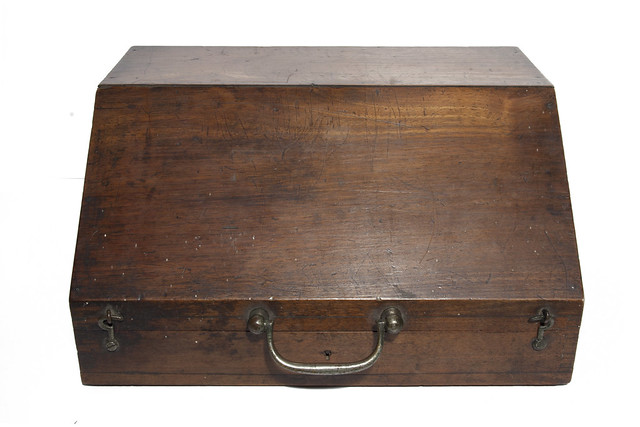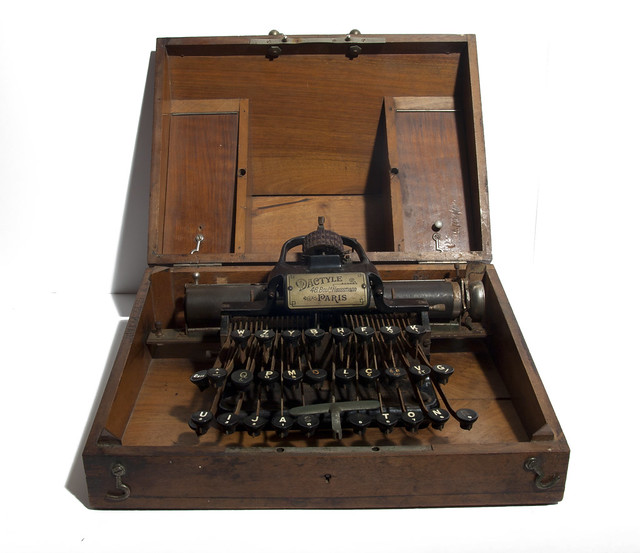It started with this wooden box I received in the mail (admittedly, I knew there was a typewriter inside, but still there is always a certain thrill about opening the case, especially around Christmas).


Dactyle, from France - very nice!!!
Manufactured in its first year of production, which was around 1895 (serial number 49!!).
But what about the inscription found on the left side of the case?
I read "Gl * P * PETAIN"
 |
| source: wikimedia commons, Bundesarchiv Bild 183-H25217 |
Now, why would this charming machine have belonged to Maréchal Philippe Pétain?
Here is my proposal:
In order to find out whether this typewriter could have belonged to "the" Pétain, we have to take the following elements into consideration and under scrutiny: the name inscription, and time and circumstances of use. From the previous owner I could by the way get no information other than he himself had found this typewriter on a Swiss market. So let's see:
The inscription is "Gl * P * PETAIN". "P" and "Pétain" would obviously fit, knowing that he was addressed as "Philippe", rather than with his real first name "Henri".
This is my "G" with superscript "l". Your opinion, please. I tried to find out whether there was a fixed code of abbreviations of military ranks for the French army in the early 20th century. It appears that at the time, there were no uniform rules on the topic. So "Gl" might well mean "Général".
Now, obviously, by World War II this typewriter would have been hopelessly outdated, but my assumption is that during World War I, Dactyle typewriters also of the first generation - as is the specimen in question - were still in use. Those were very functional and light portable machines and certainly came in handy in the field. I could not find many reports about Blicks in the field, but it is well known from Corona 3s that they were widely used in the armies. So, I would contend that this model could have been in use by French military in World War I.
But would the rank and the time coincide? Pétain is better known as Marshal of France, but this was a later title. On the eve of World War I, surprisingly enough, and Pétain being already in his late fifies, he still had not been promoted general. He had fallen out with his superiors on a question of military tactics, which explains. So he was close of taking his pension, when in 1914 the war broke out. He distinguished himself in a first battle, and was promoted General on 31st August 1914.
So, we have a name tag on the typewriter's case which would fit the General, also a fitting time-frame and circumstances likely to support the hypothesis that this machine was indeed General Pétain's. Now, your opinions please!
Read more on the Dactyle and its fascinating promotor Octave Rochefort on typewriters.ch.
P.S.: You might wonder about the hand with the star of David - this emblem is to be found on every Dactyle typewriter, it was put there by the manufacturer. Reason still unknown. The hand is a so-called "Hamsa", supposedly with apotropaic effect, and popular in both Islam and Judaism. Here it is combined with the Magen David, or Star of David.








Fascinating theory. Now get a letter written by Pétain and let the typeface expert from the lives of others compare it to your machine. :)
ResponderBorrarWord verif: dings
Wauw, that's really impressive! Such an early machine that was owned (possibly) by such a historical figure. I have googled around a little bit and I didn't succeed, but it must be possible to find a picture of Petain with this typewriter. You're close to the holy grail! :)
ResponderBorrarI am still not fully convinced, as I think it would be weird to toss around a machine of over 20 years old to a war. Especially because you'd expect a high ranked official to be able to afford a newer machine, or better yet, leave the typing to a lower ranked colleague.
Did you see this picture of Petain already? It is from the WWI period. http://www.stahlgewitter.com/16_03_06.htm
Almost!
Anyway, great post, great typewriter, great history. Thanks for sharing!
A very interesting typewriter, even if it didn't belong to "the" Pétain! But I tend to think that it did. What would "Gl." mean except Général?
ResponderBorrarA wild theory about the hand symbol: you say on your Dactyle page that Octave Rochefort's father Henri was a leading opponent of Dreyfus, hence probably an anti-Semite. Does the symbol mean "keep away Jews"? Then Pétain, future Hitler collaborator, would be a very appropriate user!
What an exciting story! Whether it is true or not, it certainly gets one thinking and makes for a fine tale. It might very well be true, but that would be difficult to confirm short of seeking out his descendants to access his personal archive. And finding a letter written on it, as Florian suggested. It is much more fun to imagine the possibilities, though! :-)
ResponderBorrarOr maybe it meant, "Give the Jews a hand"? And so far, apart from Cormac McCarthy's Lettera 22, the only typer I've seen that can definitely be attributed to a famous owner.
ResponderBorrar